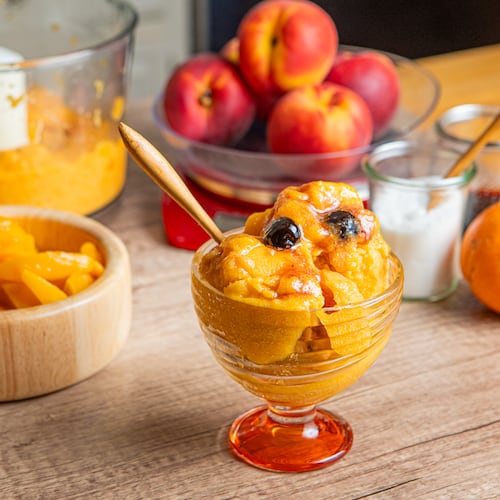I have to admit it. I never met a sweet potato I didn’t like. Cut into wedges and roasted with rosemary and salt, baked and sprinkled with brown sugar and pecans, turned into a soufflé and stuffed into an orange shell, served in a pie or baked into poundcake, a sweet potato is always delicious. Even a cold, baked sweet potato has a wonderful caramelized quality that I find irresistible.
And I feel so virtuous eating sweet potatoes. What other vegetable can claim to offer so many vitamins and minerals? There’s all that beta-carotene and vitamins C and B-6 along with iron, thiamine, niacin, manganese, copper, phosphorus and calcium. A medium sweet potato has only 130 calories and almost 4 grams of dietary fiber.
Before we jump into recipes, let’s have that “sweet potato” vs. “yam” discussion. That requires a little botanical side trip. The sweet potato is a tuber, the specialized storage root of a sweet potato plant. Sometimes people call the yellow-fleshed tubers “sweet potatoes” and the orange-fleshed tubers “yams.” But they’re both just variations on the same species, Ipomoea batatas, a member of the morning glory family.
Yams are the white-fleshed starchy tubers of an entirely different plant, Dioscorea batatas, a vine that grows only in tropical climates. Yams are also called boniato and are available at international farmers markets and in some grocery stores. The name “yam” is said to have come about when African slaves applied the name “nyami” to a vegetable that looked very much like the tropical tuber they were familiar with from their original homes.
“Sweet potatoes are the champion of vegetables!” announced 4-H member Xavier White of Ocilla in his achievement speech extolling the virtues of sweet potatoes. White lives in Irwin County, home of Georgia’s annual Sweet Potato Festival and sweet potato cook-off. Since 1960, the best cooks in Middle Georgia have been gathering the last weekend of October to see who will win first place in the categories of pies and soufflés, cakes and breads, and miscellaneous.
There are two divisions, one for cooks younger than 18, and one for the rest of us. Jenny Sutton of the Irwin County Extension office said the entries come flooding in at 9 a.m. when the doors open. Each cook can provide up to three dishes, one in each category, and the competition is fierce.
Judges base their decisions on appearance, texture, flavor and originality, and by noon, when the festival parade starts, all decisions have been made and the cash prizes have been handed out. This year marked the 49th anniversary of the cooking contest.
As you might expect, the entries leaned heavily to the sweet, with lots of pies and cakes, and relatively few in the miscellaneous category. The most unusual entries are definitely in the miscellaneous category.
“One year we had a sweet potato punch that had pineapple juice and some other things in it,” Sutton said. “The texture was grainy and sort of gritty and it just really didn’t work out.”
For the first time this year, the contest included a prize for the best overall dish, and the surprise winner was one of those miscellaneous dishes, a sweet potato salad made by Mary Register of Chula. It outshone all the dishes, even Register’s own sweet potato poundcake that won first prize in the cakes and breads category.
Recipes from past cook-offs have been compiled into “A Sweet Idea,” a cookbook published in 1996, featuring recipes from 36 years of sweet potato cooking contests. It can be purchased for $5 from the Irwin County Extension Service, 107 W. Fourth St., Ocilla, GA 31774. For information: 229-468-7409.
During the 1950s, Georgia was the leading producer of sweet potatoes. Production has dropped a little since then, but sweet potatoes are increasingly one of the world’s most important crops.
They’re relatively easy to grow, tolerate a wide variety of conditions, and an acre of sweet potatoes can provide more food energy than a similar stand of wheat or rice. The leaves can be eaten as a vegetable, cooked like other greens, and the tubers are processed into feed for animals, starch, flour, alcohol and many industrial products.
For a small-scale farmer, sweet potatoes can be a lifeline crop. The Centro Internacional de la Papa (International Potato Center) in Peru characterizes sweet potatoes as a lifesaver. For example, they fed the Japanese when typhoons destroyed rice fields and were grown in Uganda in the 1990s when a virus destroyed the cassava crops. In eastern Africa, the sweet potato is called “cilera abana” (“protector of the children”), a name that testifies to its role in combating hunger there.
Makes you feel good about enjoying your sweet potatoes at Thanksgiving this year. Good for you, good for the world — two more reasons to give thanks.
RECIPES
Balsamic-Roasted Sweet Potatoes and Butternut Squash
Hands on: 20 minutes Total time: 1 hour, 10 minutes Serves: 12
This dish is pretty irresistible even for those who expect their sweet potatoes to be sweet. A little honey tips the scale slightly to the sweet side, but the natural sweetness of the butternut squash and sweet potatoes may be all you need. These savory roasted vegetables combined with crisp arugula could be served as a saladlike first course, or as a side dish with the main meal. And it’s easy to halve or double the recipe, depending on the number of people you’re serving.
To make ahead, roast the sweet potatoes and squash a few hours or a day ahead and refrigerate up to 1 day. Heat roasted vegetables in a microwave in 2- to 3-minute intervals until just warmed through, then combine with arugula and dress with balsamic vinegar and olive oil just before serving.
4 large sweet potatoes, peeled and seeded, cut into 3/4-by-3-inch wedges
2 medium butternut squash, peeled, seeded, cut into 3/4-by-3-inch wedges
1/4 cup olive oil, plus more for drizzling
3 tablespoons balsamic vinegar, plus more for drizzling
2 tablespoons unsalted butter, melted
2 tablespoons honey, optional
1 tablespoon chopped fresh rosemary
1 teaspoon kosher salt
1/2 teaspoon black pepper
1 small bunch arugula, stems removed
Preheat oven to 400 degrees. In a large bowl, toss together sweet potatoes, squash, oil, vinegar, butter, honey, rosemary, salt and pepper. Arrange vegetables in a single layer on a rimmed cookie sheet. Roast vegetables until golden and tender, about 45 minutes, stirring every 10 minutes to encourage even cooking.
Remove from oven and allow to cool slightly. Toss vegetables with arugula and drizzle with olive oil and balsamic vinegar. Serve immediately.
Adapted from “The Martha Stewart Living Cookbook” (Clarkson Potter, $35)
Per serving: 231 calories (percent of calories from fat, 24), 4 grams protein, 44 grams carbohydrates, 6 grams fiber, 7 grams fat (2 grams saturated), 5 milligrams cholesterol, 174 milligrams sodium.
About the Author
The Latest
Featured

